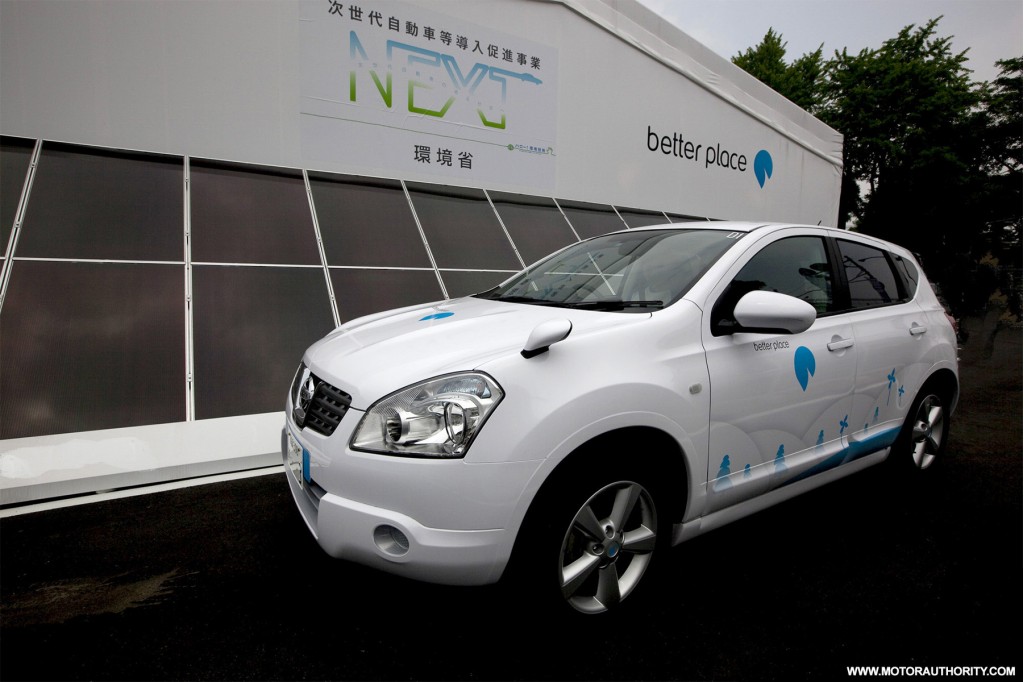To battery swap or fast-charge? That’s the question facing automakers worldwide as they decide on the best standard to adopt to charge the latest generation of electric cars.
But just like the early days of video cassettes, a standard war is waging in which there can only be one winner. And despite the quicker, fully automated world of battery swapping the technology backed by Renault-Nissan and Better Place is facing an uphill struggle to become the accepted technology for charging electric car batteries for long distance trips.
Theoretically Perfect in a Perfect World

better place battery switch station 006
Just like the Betamax, BetterPlace’s fast charge solution looks great on paper. It avoids the need for long charging stops and theoretically cuts down the time taken to replenish an electric vehicle’s range from the 30 or so minutes taken to fast charge a 2011 Nissan Leaf to well under 5 minutes.
In order to achieve this however, the battery swap station has to have no queues and a fresh battery pack of the correct type waiting. It charges the batteries to full every time and ensures a full tested battery pack that will be of a guaranteed health.
It’s also better for the batteries: continued fast charging eventually prematurely ages a lithium-ion battery pack. Battery swapping, with stations charging spent packs over hours rather than minutes helps reduce wear and tear - but only in a perfect world of unlimited space, unlimited resources and fully integrated telematics between cars, batteries and swap stations.
And that’s the point. Just like Betamax, Battery swap stations are great: in a perfect world.
Battery Homogeneity or Port Homogeneity?
Sadly, the world isn’t perfect. Nor is it one where cooperation is de facto.
In order to make full use of battery swap stations, there has to be consensus on battery pack design, not just the design of the power inlet used to charge the car. In asking the automakers to work together on a standardized battery pack, car design becomes centered around the battery pack, not the function of the car.
In turn, that centralized design process makes it difficult to design cars with longer ranges or specific purposes.
In contrast, fast charging can be applied to any vehicle with a standardized inlet: power is transferred to an on-board battery pack which can take any shape and software controls power transfer.
Port or inlet homogeneity means it is possible for battery packs to come in a variety of sizes and shapes - and the design of the battery pack can be put wherever the cars designers feel there is space.
Less Convenience, Less Space
Creating a fast-charge network is less expensive than a battery swap station. It also requires less space, meaning a fast charge station can be put anywhere a parking lot exists. Battery swap stations require a dedicated space to remove, store and charge as many batteries as are needed to satisfy a continuos stream of battery swaps.

better place battery switch station 005
Battery swapping 0. Fast Charging 2?
Kind of. But the time taken to recharge using a fast charging station is much longer than the time it takes to replace a battery in a battery swap facility. It also doesn’t actually recharge a battery to full, charging a battery to about 80% of its full capacity. These two factors give battery swap stations a major advantage over fast charge points.
The Final Nail
But the ultimate nail in BetterPlace’s coffin is the ubiquity of plugging in - and the way that we, the consumers, already know how to do it.
There’s no specialised equipment necessary for daily mileages of less than 100 miles in cars like the 2011 Nissan Leaf. In fact, charging at night eliminates the need for recharging during the day at all.
Sometimes, the more basic solution wins out, even if it isn’t quite as good for our cars as the alternative could be.
Without a doubt, fast charging is like VHS: technically flawed and not quite as versatile as it could be. For now though, BetterPlace looks confined to places where it does work: large fleets and small islands.












